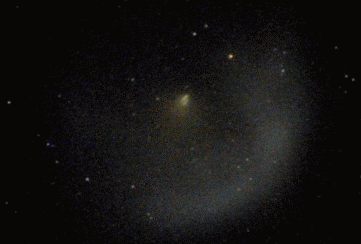 The space shuttle flies in March. Would you like a call when it soars over your backyard? Spaceweather PHONE!
The space shuttle flies in March. Would you like a call when it soars over your backyard? Spaceweather PHONE!
AURORA WATCH: Sky watchers from Scandinavia to Alaska should be alert for auroras perhaps as early as tonight but more likely on Feb. 25th. That's when a solar wind stream is due to hit Earth's magnetosphere.
A SUNSPOT WITH MANY NAMES: What do the numbers 923, 930, 935, 941 and 944 have in common? Answer: They're different names for the same sunspot, this one:

Sunspot 944: the view through a Coronado SolarMax90
Greg Piepol of Rockville, Maryland, took the picture today. It shows sunspot 944 coming around the sun's eastern limb--for the fifth time! Usually sunspots form and dissolve in a matter of weeks, but this spot has endured for more than five 27-day solar rotations. By long and idiosyncratic tradition, a sunspot receives a new number each time it reappears.
Sunspot 944 may not seem impressive now, but one month ago as "941" it was a lovely spiral. Three months ago as "930" it produced one of the strongest flares of the past 25 years and Northern Lights as far south as Arizona. What will it do this time? Stay tuned.
more images: from Gema Araujo of Merida, Spain; from Monty Leventhal of Sydney, Australia.
DEBRIS SWARM: When a Russian Briz-M rocket booster exploded over Australia on Feb. 19th, astronomer Gordon Garradd was first to report it, and he may have observed the display longer than anyone else--for nearly an hour. That gave him time to take plenty of pictures, which he has stitched together into a remarkable movie. This snippet shows a swarm of fragments expanding around the center of the blast:

Photo details: Nikon D200, 85mm lens @ f/1.6, ISO 500.
The full-length movie contains much more--a billowing cloud of rocket fuel, hundreds of stars, dozens of fragments, and several bright satellites streaking through the field of view. (How many can you count?) Click to view a medium-resolution 4 MB video or a high-resolution 20 MB video.
Experts at NASA and elsewhere are studying these images carefully, both to learn about the physics of satellite break-ups and to track the trajectory of the debris. "There is no immediate threat to the space station," says Mark Matney of NASA's Orbital Debris Office at the Johnson Space Center, "but we're analyzing the orbits to assess any long-term hazard."

